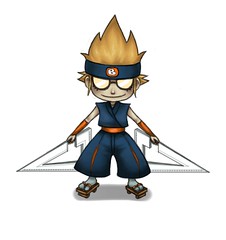Today we learned about mutually exclusive events and non-mutual exclusive events. A mutual exclusive event is when "A" occurs, it is impossible for "B" to occur. Basically means you get one or the other, never possible to get them together. It's like the question that Mr K put on about Chad: 1/3 chance he's in the lounge or a 2/9 chance he's in the library. Since i don't think there are 2 Chads' and he doesn't have some sort of magical powers, I'm pretty sure he's either in the lounge, in the library or in neither places. So, that's mutually exclusive events. The diagram that would represent it would be:

This expresses the mutual exclusive events because either one occurs in circle "A" or circle "B".
Then we learned about non-mutual exclusive events. That basically means when "A" occurs there's a possibility that "B" will occur, in layman terms, if one thing happens the other thing COULD also happen. An example would be if you have a deck of cards and you want to draw either a diamond or an ace. There's one card that would fall into the non-mutually exclusive category: the ace of diamonds. So that part of it would be non-mutually exclusive.

This picture represents a non-mutual exclusive event because one can occur in "A", also in "B" or it could occur in the intersection "AB".
The formula to calculate the mutual exclusive events and non-mutual exclusive events are the same, which is:

So basally in a mutual exclusive event you would just add the probability of "A" and the probability of "B" and subtract zero because it's impossible for the two things to occur together. While in a non mutual exclusive event, you have to minus the probability of "AB" because you would account an event twice. Kind of confusing right? Here's an example: the card one: whats the probability of getting a ace or diamonds? Well you would have 4/52 because you have 4 aces in a deck and 52 cards in a deck. For diamonds you would have 13/52 because you have 13 diamonds and 52 cards, BUT you have accounts for the ace of diamonds TWICE. Once when you considered it an ace and once when you considered it a diamond, but they're the same card so you can't do that. That's why you subtract the probability of "AB, which would be 1 since you can only have 1 card which is both an ace and a diamond. So you end up with 16/52.
Uhh, well that's basically it and apparently we're wrapping this unit up tomorrow (if I remember correctly). Soo, yeah good luck with life and next scribe is ... lets' go with Pacifico.

